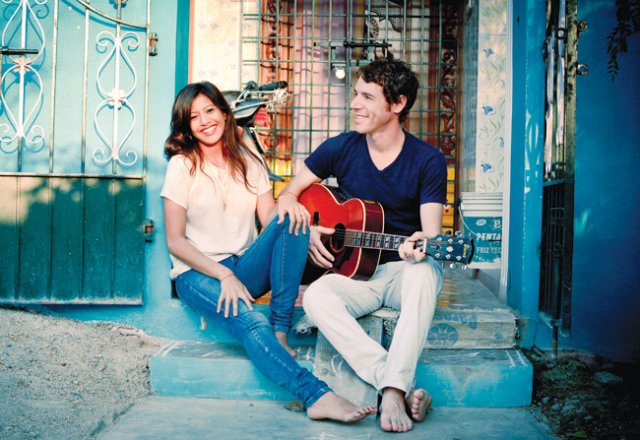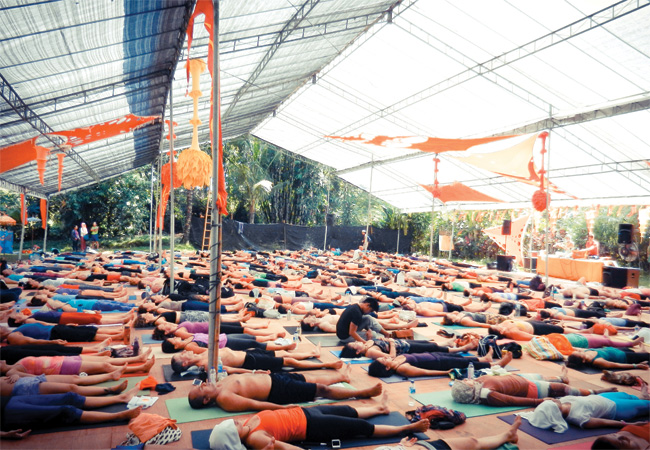
The magic of mantra music (kirtan)

Edo & Jo unite yogis worldwide
When Sydney-based singer-songwriter Jo Mall Kahn attended a Balinese yoga retreat in 2008, she discovered a gem more precious than she could have imagined – her now-husband, Edo Kahn. Upon hearing him chant the ancient Gayatri mantra, her heart exploded.
It was also love at first listen for Edo, who instantly fell in love with Jo’s soothing vocals. Their instant connection sparked an unbreakable bond as devotional music duo Edo & Jo (pictured).
Together, they unite yogis worldwide with modern adaptations of yogic chanting known as kirtan (‘keer-tahn’). Diana Timmins takes a look at the age-old healing modality.
Music is a universal language that connects people from all walks of life, including those claiming to be tone deaf or have two left feet. Kirtan is a particularly moving genre in many aspects. So, despite common misconception, yoga is more than twisting like a pretzel. And yogic chanting, like the renowned ‘OM’, serves greater purpose than a mere modern stereotype – and doesn’t require a sweet songbird voice!
“Just as yoga is not about how far you can bend, kirtan is not about how well you can sing. We have each been given a perfect instrument, our body. Kirtan helps us find peace within our body and freedom from any inhibition to express our unique voices and truths,” says Edo.
Birth and re-birth of bhakti
The ancient Indian Sanskrit word yoga translates to ‘union’, which can be multifaceted. Not only can physical applications unite body, mind and breath, but yoga’s vast toolbox can also unite communities, and, ultimately, us with our true selves. Yoga’s recent boom in the west has given rise to a smorgasboard of modernised styles; many with strong and sweaty physical emphasis. We are, however, also blessed with a revival of bhakti (devotional) yoga, encompassing ancient philosophy, worship and vocal expression.
Bhakti is referenced in Vedic scriptures over four thousand years old, with kirtan undoubtedly the most popular of its practices today.
“Kirtan and bhakti are said to be yoga for the 21st century. The thinking being that modern man can only be reminded of his true nature by worshipping God in a form,” says Byron Bay-based yoga teacher, John Weddepohl, who travels te world with his partner, Rachel Zinman, to share bhakti.
“Bhakti is a beautiful way of practicing yoga,” adds Zinman. “It allows for reflection of the nature of love. Words like yoga, self, love; they all describe the same thing.”
Like yoga itself, it is difficult to determine kirtan’s exact inception. Biography of bhakti pioneer Saint Krishna Chaitanya Mahaprabhu (The Birth of Kirtan: The Life and Teachings of Chaitanya, 2012), claims he began the practice in India over 600 years ago. Kirtan was then brought to the west in the 1960s by spiritual teacher Abhay Charanaravinda Bhaktivedanta Swami Prabhupada. This movement inspired many established musicians – including The Beatles’ George Harrison– who produced the well-known The Radha Krishna Temple album in 1969. Kirtan’s popularity continues to blossom with regular worldwide events, some drawing thousands of devotees from across the globe.

Collective kirtan ‘buzz’
Kirtan loosely means ‘to repeat’, and involves repetitive chanting of significant phrases and divine names, such as Saraswati (goddess of creativity), Shiva (pure consciousness, masculine aspect), Shakti (creative force of universe, feminine aspect) and Ganesha (remover of obstacles), to name a mere few. While each symbolise unique characteristics, none are considered superior.
“All names and forms of the divine represent the one divine consciousness existing in and through everything; thus, no one form is considered holier than another. Although seemingly separate, they are in fact different names for the same thing. Any form the devotee chooses as most meaningful represents the divine and is considered their Ishta Deva,” explains Weddepohl.
Kirtan has a warm and welcoming environment, for which people gather humbly upon the floor on bolsters or cushions. The atmosphere is often enhanced with soft lighting, candles, mandalas (circular symbol of unity), photos and flowers as offerings to deities. One or two singers lead call-and-response style, accompanied by modern and classical Indian instruments.
As songs evolve, tempo and volume of instruments and voices rise. The energy becomes electrifying as the crowd sings with one voice. Reaching its crescendo, many stand, sway, clap and dance as if their bodies move involuntarily. Eventually, the mantra fades, followed by a collective contemplative silence. The experience is incredibly uplifting and activates a noticeable (and natural!) buzz.
“A beautiful thing about kirtan is that everyone lets go and sings together. Sometimes they don’t even know what they are singing, but whatever they have been holding on to disappears. Why? Because in that moment, the sense of ‘I’ is suspended, we don’t have to be anyone and it is so freeing,” says Zinman.
Those a little introverted shouldn’t shy away from the practice, as simply absorbing the atmosphere and chanting inwardly can be just as powerful.
Connecting with nature
Newcomers may experience a degree of kirtan confusion, perhaps resistance. What do Sanskrit words mean? What is the purpose of kirtan? Is it a religious act? Despite seemingly convoluted, such queries have relatively straightforward answers. Put simply; kirtan is a liberating process of letting go to foster connections with the blissful nature within and without.
“All mantras and divine names sung in kirtan are inherent sound vibrations of nature. In ancient times, rishis or sages heard and synthesised the sounds of nature while in meditation, and this collection of Sanskrit mantras became the Vedas. This means that kirtan and yoga are essentially from nature, and don’t belong to any group or religion,” says Jo.
Most chants share a recurring theme of surrender to the divine, compassion and peace for all creations. Understanding meanings behind each individual word is an overwhelming notion, but – relax – one that is not as important as the experience itself.
“While understanding meanings can be helpful, it is not essential. The vibrations of Sanskrit are designed to communicate with our soul and take us beyond the realm of mind and thought. Many sounds stir emotions and physical body – making us feel happy or sad, like dancing or sleeping – but chanting is the tool to connect us with the unconditionally loving nature of our soul,” explains Edo.
Yogic philosophy identifies bliss (anandam) as the true nature of all humans. Pressures of daily life cloud this occasionally, but we can all reconnect with our innate peace.
“Human beings love happiness; we are all bliss junkies. Has anyone ever loved unhappiness? Never! We seek happiness in everything.
By singing kirtan, we can let go and be closest to the truth of who we are by being with our bliss nature,” Weddepohl enthuses.
Healing power of sound
A growing body of scientific research supports ancient wisdom that chanting promotes holistic healing. In his book Self-Healing: Powerful Techniques (Health Psychology Association, 1997), Dr Ranjie Singh discusses findings from Canada’s Western University, chanting specific mantras may release the hormone melatonin, which can shrink tumours and improve sleep. Further studies by founder of Boston’s Mind/Body Medical Institute, Dr Herbert Benson, revealed chanting aids stress reduction by triggering a relaxation response that reduces heart rate, brainwaves and respiration.
“We spend so much time identifying with thoughts and emotions, which creates significant stress in the body. Stress can start off minimal, but eventually progress to the point of triggering disease. The more we occupy the mind in a neutral activity like chanting, the freer one is from the habitual need to identify, and the more healing takes place,” says Zinman.
Chanting can also be therapeutic on an energetic level; that which may not be seen by the naked eye, but imperative to wellbeing. According to Jo, vibrations of chanting balance our chakras, calm our minds and open our hearts.
“Chakras are energy centres connected to our organs, nervous system, emotions and thoughts. The throat chakra (vishuddha) is the bridge between head and heart. Opening and balancing this chakra helps us with authentic expression, which means tuning within to express that which is kind, beneficial and truthful. There is no greater healing than connecting with the essence of who we are,” she says.
Whether you experience love within, without or – like Edo & Jo – with another through the magic of mantra, it is undoubtedly an experience that can change the way you look at things so greatly that the things you look at subsequently change. Life might seem serious and complicated sometimes, but can be simplified in the famous wise words of George Harrison: chant and be happy! NH
Visit edoandjo.com/bliss for a free download of Siddhi Buddhi from Edo & Jo’s latest album Bliss.


